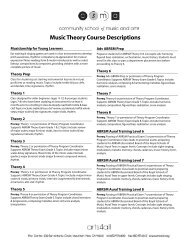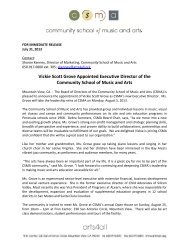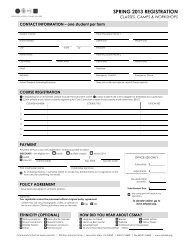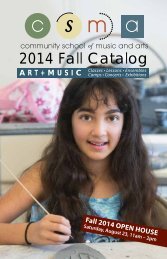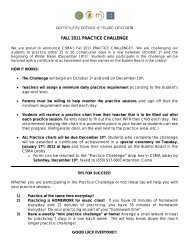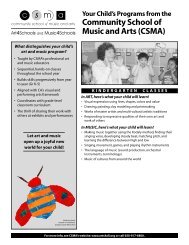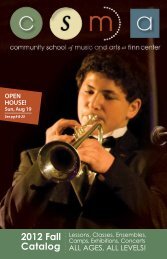Making - Community School of Music and Arts
Making - Community School of Music and Arts
Making - Community School of Music and Arts
You also want an ePaper? Increase the reach of your titles
YUMPU automatically turns print PDFs into web optimized ePapers that Google loves.
The<br />
<strong>Community</strong><br />
<strong>School</strong> <strong>of</strong> <strong>Music</strong><br />
<strong>and</strong> <strong>Arts</strong> (CSMA)<br />
at Finn Center is Silicon<br />
Valley’s undisputed leader<br />
in arts education. At the<br />
heart <strong>of</strong> CSMA’s mission is<br />
ARTS FOR ALL! Since our<br />
founding in 1968 as a nonpr<strong>of</strong>it<br />
organization, CSMA<br />
has served more than 300,000<br />
people <strong>of</strong> all ages, abilities,<br />
backgrounds & financial circumstances<br />
through: music,<br />
visual & digital arts classes,<br />
lessons, camps; arts-inthe-schools<br />
programs;<br />
free concerts, lectures,<br />
exhibitions & community<br />
outreach<br />
events.<br />
<strong>Making</strong><br />
A Resource for Parents<br />
<strong>and</strong> Preschoolers<br />
Haciendo Arte<br />
Un recurso para los<br />
padres y los niños en<br />
etapa preescolar<br />
Copyright © 2006<br />
230 San Antonio Circle, Mountain View, CA 94040 | 650.917.6800 | www.arts4all.org<br />
This project has been made possible by a grant from FIRST 5<br />
<strong>Arts</strong> Grant Program, a program <strong>of</strong> <strong>Arts</strong> Council Silicon Valley<br />
in partnership with FIRST 5 Santa Clara County <strong>and</strong> the Los<br />
Altos <strong>Community</strong> Foundation.<br />
Supported by the AEG <strong>Arts</strong> Grants Program <strong>of</strong> <strong>Arts</strong> Council Silicon Valley
El arte y el niño<br />
de preescolar<br />
<strong>Making</strong> the Most<br />
<strong>of</strong> the Experience<br />
Ideas for Parents During Class<br />
Mi hijo es muy pequeño.<br />
¿Por qué es importante el arte<br />
Los niños aprenden experiment<strong>and</strong>o y jug<strong>and</strong>o. El arte es un<br />
emocionante medio para aprender. El arte le dará a su hijo la<br />
alegría y satisfacción que son intrínsecas del proceso artístico.<br />
Aunque el arte ya es importante en sí, éste está también ligado de<br />
manera importante al desarrollo intelectual y social del niño:<br />
Preparación para aprender a leer y escribir<br />
Habilidades para resolver problemas<br />
Conceptos matemáticos<br />
Relaciones entre las partes y los enteros<br />
Pensamiento simbólico<br />
Independencia<br />
Implicaciones sociales<br />
Photo document the class.<br />
Ask questions about the process.<br />
Keep a class journal.<br />
Work in your own space alongside<br />
your child, modeling appropriate<br />
behavior.<br />
Share ideas & experiences with other parents.<br />
Comment on the process & experience, not on the end product. Instead<br />
<strong>of</strong> asking “What is this” or stating “That is beautiful.” say: “You used<br />
some interesting lines & shapes.” or “That yellow is very bright. How<br />
does that make you feel”<br />
Ideas to Take Home<br />
Encourage your child to share artwork & experience with<br />
others.<br />
Repeat lessons at home. Practice cutting, gluing, painting & ripping paper.<br />
Read books about the topic <strong>of</strong> the day or find information online & share.<br />
Create a book report: read a book; create art about the story.<br />
Look at art in other places: museums, stores, magazines, books, the internet,<br />
murals, etc.<br />
2 19
Aprovech<strong>and</strong>o<br />
al máximo la<br />
experiencia<br />
Ideas para los padres<br />
durante la clase<br />
Documenta las clases a través de fotografías.<br />
Pregunta acerca del proceso.<br />
Trabaja en tu propio espacio junto a tu hijo,<br />
enseñándole un ejemplo de comportamiento.<br />
Comparte ideas y experiencias con otros padres.<br />
Haz un cuaderno de la clase.<br />
Platica sobre el proceso y la experiencia, no del resultado final. En lugar<br />
de preguntar “¿Qué es esto” o de decir “Eso esta bonito.” di: “Usaste<br />
líneas y figuras muy interesantes.” o “Ese Amarillo es muy brillante.<br />
¿Qué te hace sentir”<br />
Ideas para llevarse a casa<br />
Anima a tu hijo a compartir su trabajo y experiencia<br />
con otros.<br />
Repite los trabajos en casa. Practica recort<strong>and</strong>o, peg<strong>and</strong>o, pint<strong>and</strong>o y recort<strong>and</strong>o<br />
papel.<br />
Lee libros acerca del tema del día o busca información en Internet y<br />
compártela.<br />
Crea un libro de reportes: lee un libro y crea arte acerca de su historia.<br />
Observa el arte en otros lugares: museos, galerías, tiendas, revistas, libros,<br />
internet, murales, etc.<br />
Art & the Preschool Child<br />
My child is so young.<br />
Why is art important<br />
Children learn through experimentation<br />
& play. Art<br />
<strong>of</strong>fers an exciting environment<br />
for this learning. Art provides your<br />
child with joy & satisfaction that<br />
is intrinsic in the art-making process. While art is<br />
important for its own sake, it also has important links to<br />
your child’s intellectual & social development:<br />
Reading & writing readiness<br />
Problem-solving skills<br />
Mathematical concepts<br />
Whole/part relationships<br />
Symbolic thinking<br />
Autonomy<br />
Socialization<br />
18<br />
3
¿Qué es una<br />
línea<br />
Kids & Creativity<br />
Existen muchos tipos de<br />
líneas: rectas, onduladas, en zig-zag,<br />
gruesas, delgadas, cortas, largas, punteadas, y espirales.<br />
¿Puedes dibujar una línea en el aire ¿Ves algún tipo de<br />
líneas en tu ropa ¿Qué pasa si repites algunas líneas<br />
LAS LETRAS están formadas por líneas.<br />
¿Qué tipo de líneas forman estas<br />
letras: S, T, B, X, M, C <br />
Beads on a pipe cleaner make an interesting line!<br />
Arte en casa<br />
Granos en un limpiador de pipa hace una línea muy interesante!<br />
Algunos materiales son más fáciles de<br />
usar para los niños. Plumones y lápices<br />
son muy buenos instrumentos de dibujo<br />
para manos pequeñas. Dibujar con gises<br />
en banquetas y patios les da a los niños un<br />
gran lienzo lavable para expresarse.<br />
Art at Home<br />
Some materials are easier for a child to<br />
use than others. Markers & beginner<br />
pencils are great drawing tools for small<br />
h<strong>and</strong>s. Drawing with sidewalk chalk on<br />
walkways & patios gives children a large<br />
& washable canvas for self-espression.<br />
The At-Home Art Cart<br />
Keep supplies organized & visually appealing.<br />
Crayons | Wood pieces | Play dough or clay | Magazines or newspapers |<br />
Recycled materials | Glue (bottles, sticks) | Paint brushes (various sizes) |<br />
Child’s scissors | Paper (white, colored, recycled, various shapes & sizes) |<br />
Paint (tempera & watercolors) | Tape (masking, clear, double-sided)<br />
Art in Daily Life<br />
Play a sorting game with your child. Sort materials<br />
by color, shape or texture into plastic containers.<br />
Gather materials on walks in your neighborhood.<br />
Leaves are great for crayon rubbings. Look at &<br />
talk about the shapes <strong>of</strong> seeds, flower petals &<br />
rocks with your child.<br />
Design a sidewalk chalk game with your child.<br />
Follow a line <strong>of</strong> squares to discover the red heart,<br />
the blue circle, the yellow triangle. It can become<br />
a counting game as well. Go forward two green<br />
squares, back one, etc.<br />
4 17
Niños y<br />
creatividad<br />
What is a Line<br />
Tu carrito artístico de<br />
herramientas en casa<br />
Mantén los materiales ordenados y visualmente atractivos.<br />
El arte en la vida diaria<br />
WEBSITES<br />
www.arts4all.org<br />
www.enchantedlearning.com<br />
www.freekidscrafts.com<br />
www.kidsdomain.com<br />
www.makingfriends.com<br />
Find more at www.google.com<br />
(Type in a phrase such as<br />
“preschool crafts” or<br />
“art for kids.”)<br />
Crayolas | Pedazos de madera | Barro o plastilina |<br />
Materiales reciclados | Botes y barras de pegamento | Pintura (tempera<br />
y acuarelas) | Tijeras para niños | Pinceles (de varios tamaños) | Cinta<br />
adhesiva (masking, transparente, doblecara) | Revistas o periódicos |<br />
Papel (blanco, de colores, reciclado, de diferentes formas y tamaños)<br />
Diviértete con un juego de ordenar con tu hijo. Ordena los materiales en contenedores<br />
de plástico, separándolos por color, forma y textura.<br />
Reúne los materiales que encuentres camin<strong>and</strong>o por tu vecindario. Las hojas de los<br />
árboles son geniales para frotar formas con crayolas y marcar formas en ellas. Observa y<br />
platica con tu hijo acerca del color de las semillas, los pétalos y las piedras.<br />
Dibuja un juego con gises en la acera para jugar con tu hijo. Haz que sigan una línea de<br />
cuadrados hasta descubrir el corazón de color rojo, el círculo azul, el triángulo amarillo,<br />
etc. También se puede convertir en un juego para contar: “camina dos cuadrados verdes<br />
hacia adelante,” “regresa uno,” etc.<br />
There are many types <strong>of</strong> lines: straight,<br />
wavy, zig-zag, thick, thin, short, long,<br />
dotted, curly.<br />
Can you draw a line in the air Do you see<br />
any lines on your clothes What happens if<br />
you repeat lines<br />
LETTERS are made <strong>of</strong> lines. What kinds <strong>of</strong> lines make up<br />
these letters: S, T, B, X, M, C <br />
Notas para el<br />
desarrollo<br />
Los niños de preescolar<br />
pueden disfrutar el<br />
movimiento de cu<strong>and</strong>o<br />
hacen marcas mientras<br />
aprenden a controlar<br />
sus cuerpos. A veces,<br />
ellos crean sonidos o se<br />
cuentan historias para ayudarles a expresar<br />
el significado de estas marcas.<br />
Developmental<br />
Notes<br />
Preschool children<br />
enjoy the movement<br />
<strong>of</strong> making<br />
marks as they learn<br />
to control their<br />
bodies. They sometimes<br />
make sounds<br />
or tell stories that<br />
help them express the meaning <strong>of</strong><br />
their marks.<br />
16 5
¿Puedes ver las<br />
formas<br />
Environmental<br />
Art<br />
Mira bien a tu alrededor y verás muchas formas básicas<br />
como círculos, triángulos, cuadrados y rectángulos. ¿Qué<br />
forma tiene una pelota, la vela de un barco, las ruedas, un<br />
edificio o una ventana<br />
La figuras simples se combinan para formar<br />
figuras más complicadas. ¿Cuántas figuras<br />
puedes ver en una casa, un camión, una flor o<br />
un papalote<br />
La repetición de figuras crea<br />
patrones. ¿Llevas hoy algún<br />
patrón en tu ropa<br />
A collage is made by assembling parts into a new whole. You<br />
can make something new using recycled materials. What<br />
would you like to invent What parts <strong>of</strong> your<br />
invention can you find in your recycling bin<br />
Have you ever seen a robot If you made<br />
your own robot, what could you use<br />
to make the head arms body<br />
Can you rip up junk mail &<br />
create a picture<br />
Arte en casa<br />
Art at Home<br />
Recortar es una actividad Cutting is a difficult skill. Show<br />
difícil. Enseña a tu hijo cómo your child how to make shapes from<br />
Notas para el desarrollo Developmental<br />
recortar un triángulo cort<strong>and</strong>o la esquina de construction paper by cutting <strong>of</strong>f the<br />
Refuerza el pensamiento independiente pero<br />
Notes<br />
un pedazo de papel de construcción o cort<strong>and</strong>o corner <strong>of</strong> a piece <strong>of</strong> paper for a triangle<br />
ahórrales la frustración cu<strong>and</strong>o tus hijos Reinforce independent thinking,<br />
una línea a través de una hoja de papel para or cutting a line through paper for a<br />
tengan problemas para manejar un material. but head <strong>of</strong>f extreme frustrations when your<br />
formar un rectángulo o un cuadrado. Añade rectangle or square. Add these shapes<br />
Puedes ayudarle deteniendo el papel mientras<br />
tu hijo lo recorta, aplica el pegamento You can dab glue & hold objects to be glued<br />
child has difficulty manipulating materials.<br />
estas formas a otras que ya estén cortadas de to precut circles, hearts, triangles &<br />
círculos, corazones, triángulos y cuadrados. squares. Encourage your child to put<br />
y junta objetos. Incrementa sus habilidades together or hold paper while your child cuts,<br />
Anima a tu hijo a unir estas simples formas these simple shapes together to make<br />
para resolver problemas, permitiendo que el but encourage problem-solving skills by<br />
para crear una casa, un barco o una cara. a house, a boat, a face.<br />
niño tome decisiones creativas. allowing your child to make creative decisions.<br />
6 15
Arte ecológico<br />
Do You See<br />
Un collage está<br />
formado por partes<br />
que, juntas, crean un<br />
todo. Utiliz<strong>and</strong>o materiales<br />
reciclados puedes crear algo<br />
nuevo. ¿Qué te gustaría inventar ¿Qué<br />
partes para tu invento puedes encontrar<br />
en el bote de material reciclable<br />
¿Alguna vez has visto un robot ¿Si<br />
haces tu propio robot, qué podrías usar<br />
para la cabeza, los brazos y el cuerpo<br />
¿Puedes recortar el correo que no sirve<br />
y crear una imagen<br />
Arte en casa<br />
Look all around & you will see many basic shapes such as circles,<br />
triangles, squares & rectangles. What shape is a ball, the sail on<br />
a boat, wheels, a building or a window<br />
Simple shapes combine to make more complex shapes. How<br />
many shapes can you see in a house, a bus, a flower or a kite<br />
Repeating shapes<br />
create a pattern.<br />
Are you wearing<br />
any patterns<br />
today<br />
Notas<br />
para el desarrollo<br />
Shapes<br />
Developmental<br />
Notes<br />
At some point in<br />
Recolecta las envolturas de dulces, cartones<br />
Art at Home<br />
his or her scribbling,<br />
de huevo, papel de baño, toallas de papel y Save c<strong>and</strong>y wrappers, egg cartons,<br />
En el garabateo de tu hijo<br />
your child will<br />
los rollos de cartón de las toallas de papel, toilet paper & paper towel rolls,<br />
llegará un momento en el que<br />
begin creating<br />
contenedores de plástico, tapaderas, corchos, plastic containers, lids, corks, bottle<br />
él comenzará a crear figuras<br />
rudimentary shapes<br />
tapas de botellas, pequeñas cajas o cartones de caps, small food boxes or cartons, old<br />
rudimentarias a las que él<br />
& attaching names<br />
comida; viejos cd’s, piñas de pino, bellotas, etc. CDs, pine cones, leaves, acorns, etc. A<br />
otorgará nombres. Éstas pueden tener muy poco to these shapes. They may bear little<br />
Un bote de leche pintado o cubierto de papel milk carton painted or covered with<br />
parecido al objeto que representan, pero estas resemblance to the actual object but<br />
con algunas tapas de botellas puede convertirse construction paper & some bottle caps<br />
figuras son una especie de símbolo para tu hijo. are a sort <strong>of</strong> symbol for your child.<br />
en un camión o un autobús. can become a truck or a bus.<br />
Esta creación de símbolos es un vínculo importante This symbol-making is an important<br />
14<br />
para aprender a leer y escribir. link to literacy.<br />
7
¡Vamos a usar<br />
colores!<br />
Can You Make a Form<br />
Rojo, azul y<br />
amarillo se pueden<br />
combinar para formar todos<br />
los colores.<br />
¿Qué pasa si mezclas pintura roja y amarilla<br />
¿Si pones azul sobre amarillo, qué color formas<br />
¿Puedes crear un nuevo color con rojo y azul<br />
Puedes hacer un color más claro o más obscuro agregándole<br />
blanco o negro. ¿Qué<br />
color haces si<br />
mezclas rojo y<br />
blanco<br />
Manipulating material with your<br />
h<strong>and</strong>s is called forming. You can<br />
create 3-dimensional sculptures this way!<br />
Many materials can be formed. Make sculptures with<br />
things in nature or around the house. Mud &<br />
s<strong>and</strong> mixed with water are<br />
both great sculpting materials.<br />
What can you<br />
make out <strong>of</strong> an egg<br />
carton or a paper plate<br />
& pipe cleaners<br />
Arte en casa<br />
Art at Home<br />
Los colores primarios<br />
Notas para el desarrollo Developmental Notes<br />
son el rojo, el azul y el<br />
The primary colors<br />
Reconoce que el arte de los niños refleja<br />
amarillo y son usados<br />
are red, blue & yellow<br />
Recognize that the art <strong>of</strong> young children<br />
su desarrollo. Su progreso de garabatear<br />
para hacer todos los demás<br />
& are used to make all<br />
reflects their development. Their<br />
al trazo de símbolos y creación de<br />
colores. Us<strong>and</strong>o los colores<br />
other colors. Using just<br />
movement from scribbling to symbolmaking<br />
to creating representational<br />
dibujos representativos ocurre en etapas<br />
primarios, y el blanco y el negro, el<br />
the primary colors, along with<br />
individuales y este proceso no se beneficia<br />
niño puede experimentar la mezcla de los white & black, your child can experience<br />
drawings occurs at individual rates & does<br />
si se acelera de manera forzada.<br />
colores. Deja que tu hijo descubra qué pasa mixing colors. Let your child discover<br />
not benefit from forced acceleration.<br />
cu<strong>and</strong>o el amarillo se mezcla con el rojo o what happens when yellow mixes with<br />
8 cu<strong>and</strong>o el rojo se mezcla con el blanco. red or red mixes with white.<br />
13
¿Puedes<br />
Let’s Use Colors!<br />
hacer una forma<br />
Se le llama<br />
“moldear” a manipular<br />
materiales con las manos. ¡De esta<br />
manera puedes formar esculturas tridimensionales!<br />
Muchos materiales pueden ser moldeados. Crea esculturas<br />
us<strong>and</strong>o cosas de la naturaleza o que encuentres en tu casa.<br />
Tierra y arena mezcladas con agua son excelentes materiales<br />
para moldear. ¿Qué puedes crear con un cartón de huevos o<br />
un plato de papel y limpiapipas<br />
Red, blue & yellow can be<br />
mixed to make all other colors.<br />
What happens if you mix red & yellow<br />
paint If you color blue over yellow,<br />
what color do you get Can you<br />
make a new color with red &<br />
blue<br />
You can make a color lighter<br />
or darker by adding white or<br />
black. What color do you get<br />
when you mix red & white<br />
Arte en casa<br />
¿Qué puedes hacer con plastilina Puedes<br />
aplastarla hasta crear una forma, aplanarla con un<br />
rodillo o rodarla para crear una víbora. Elabora tu<br />
propia plastilina siguiendo esta simple receta:<br />
Art at Home<br />
What can you make with play dough<br />
You can squish it into a shape, flatten it with a<br />
rolling pin or roll it into a snake. Try making<br />
your own play dough by following this simple<br />
recipe:<br />
Notas para el desarrollo<br />
Developmental Notes<br />
Los primeros dibujos de los niños consisten Children’s first paintings usually consist<br />
normalmente en gr<strong>and</strong>es áreas de color pintadas<br />
una arriba de otra. Después, progresan <strong>of</strong> the other. They progress to painting<br />
<strong>of</strong> large areas <strong>of</strong> color painted one on top<br />
• 1 taza de harina<br />
• 1 taza de agua caliente<br />
• 1 cup flour<br />
a pintar manchas de color, una junta a la otra. patches <strong>of</strong> color next to each other. Young<br />
• 2 cucharaditas de crema de tártaro • 1 cup warm water<br />
• 1 cucharadita de aceite<br />
• 2 teaspoons cream <strong>of</strong> tartar<br />
Los niños pequeños eligen los colores por su children choose color based upon interest<br />
• 1/4 taza de sal<br />
• 1 teaspoon oil<br />
propio interés, no por la relación que tenga el & not for its resemblance to the color <strong>of</strong><br />
• Colorante artificial<br />
• 1/4 cup salt<br />
color con lo que están pint<strong>and</strong>o. the object being painted.<br />
12 • food coloring<br />
9
Toca una textura<br />
Touch a<br />
!<br />
Una textura es la manera como algo se<br />
siente o la manera como parece que se va a<br />
sentir. Las texturas pueden ser abolladas, suaves,<br />
rugosas, lizas, filosas... ¿Cuántas texturas puedes sentir<br />
Toca tu cabeza. ¿Qué sientes ¿Se siente igual<br />
que cu<strong>and</strong>o tocas tus cachetes Toca con los<br />
pies. ¿Qué sienten tus pies ¿Se siente como<br />
pasto o como arena de playa<br />
El sentir “recolecta” la textura de un objeto.<br />
¡Utiliza una crayola y un papel para recolectar<br />
la textura del papel para<br />
lijar o de la hoja de un árbol!<br />
Arte en casa<br />
Comúnmente, los niños<br />
cuentan historias cu<strong>and</strong>o están<br />
dibuj<strong>and</strong>o. Copia sus historias<br />
y adhiérelas a sus dibujos para crear un<br />
libro sencillo. Crea un libro de texturas,<br />
encuadern<strong>and</strong>o sus raspados de superficies<br />
con crayola en papel. Arroja un poco<br />
de pintura y pégalo en papel.<br />
Art at Home<br />
Children <strong>of</strong>ten tell stories while they<br />
are drawing. Record their stories &<br />
staple them together with their drawings<br />
to create a simple book. Make a<br />
book <strong>of</strong> textures by binding together<br />
crayon rubbings & surface prints. Dab<br />
tempera on the surface <strong>of</strong> an object &<br />
stamp it on paper.<br />
A texture is what something feels<br />
like, or looks like it might feel.<br />
Textures can be bumpy, smooth, rough, flat, sharp... how<br />
many textures can you feel<br />
Touch your head. What do you feel Does it feel the same as<br />
touching your cheeks Touch with your feet. What do your<br />
feet feel Does it feel like grass or s<strong>and</strong> on a beach<br />
Rubbings “collect” an object’s texture. Use a peeled crayon &<br />
a piece <strong>of</strong> paper<br />
to collect<br />
the texture <strong>of</strong><br />
s<strong>and</strong>paper or a<br />
leaf!<br />
Notas para el<br />
desarrollo<br />
Texture<br />
Developmental<br />
Notes<br />
Two-, three- &<br />
four-year olds<br />
enjoy tactile<br />
experiences. They<br />
learn through<br />
their sense <strong>of</strong><br />
touch as much as<br />
by verbal instruction.<br />
Spatial intelligence, or the<br />
ability to think in pictures, develops<br />
through the use <strong>of</strong> visual<br />
Los niños de dos, tres y<br />
cuatro años disfrutan<br />
las experiencias táctiles.<br />
Ellos aprenden de igual<br />
manera us<strong>and</strong>o el sentido del tacto que de las<br />
instrucciones verbales. La inteligencia espacial, o<br />
la habilidad de pensar en imágenes se desarrolla<br />
10<br />
a través de experiencias visuales y táctiles. & tactile experiences.<br />
11



